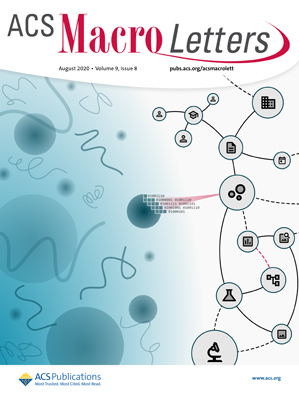定制Diels-Alder交联液晶弹性体用于空间可编程单片执行器
IF 5.2
Q1 POLYMER SCIENCE
引用次数: 0
摘要
具有热可逆Diels-Alder交联(DALCEs)的液晶弹性体具有卓越的可再加工性和温和的可再编程性,可以重复制造各种执行器。然而,优化它们的分子设计和再制造方案对于进一步释放它们的潜力仍然至关重要。本研究系统地研究了RM82、糠胺和各种扩链剂(苯乙胺、乙胺、丁胺、己胺、辛胺和6-氨基-1-己醇)之间通过aza-Michael加成反应合成的DALCEs。交联密度和扩链剂的选择对相行为、热机械性能和驱动性能的影响已经得到了全面的研究。结果表明,交联密度适中的pea基配方性能最平衡。在此优化配方的基础上,利用dalce固有的可再加工性、可再编程性和自愈性,提出了一种新的(再)制造策略。该策略在单片致动器形成之前采用多层光纤编程,实现了空间控制液晶对准,并便于通过重构对致动器进行迭代改进。因此,证明了盘膜的复杂变形行为和管状致动器的应力调节功能。这项工作为空间可编程的动态单片驱动器建立了一个通用的,易于合成的材料平台,为软机器人和自适应设备的先进应用铺平了道路。本文章由计算机程序翻译,如有差异,请以英文原文为准。

Tailoring Diels–Alder Cross-Linked Liquid Crystal Elastomers for Spatially Programmable Monolithic Actuators
Liquid crystal elastomers with thermo-reversible Diels–Alder cross-links (DALCEs) offer exceptional reprocessability and mild-temperature reprogrammability, enabling repeated fabrication of diverse actuators. However, optimizing their molecular design and refabrication protocols remains crucial to further unlocking their potential. This work systematically investigates DALCEs synthesized via aza-Michael addition reactions between RM82, furfurylamine, and various chain extenders (phenylethylamine, ethylamine, butylamine, hexylamine, octylamine, and 6-amino-1-hexanol). The effects of cross-linking density and chain extender selection on phase behavior, thermomechanical properties, and actuation performance have been thoroughly examined. The results show that a PEA-based formulation with moderate cross-linking density achieves the most balanced performance. Based on this optimized formulation, a novel (re)fabrication strategy is introduced by harnessing DALCEs’ intrinsic reprocessability, reprogrammability, and self-healing properties. This strategy employs multilevel fiber programming before monolithic actuator formation, enabling spatially controlled liquid crystal alignment and facilitating iterative actuator refinement through reconstruction. Consequently, complex morphing behaviors in disk films and stress-modulating functions in tubular actuators were demonstrated. This work establishes a versatile, easily synthesized material platform for spatially programmable, dynamic monolithic actuators, paving the way for advanced applications in soft robotics and adaptive devices.
求助全文
通过发布文献求助,成功后即可免费获取论文全文。
去求助
来源期刊
CiteScore
10.40
自引率
3.40%
发文量
209
审稿时长
1 months
期刊介绍:
ACS Macro Letters publishes research in all areas of contemporary soft matter science in which macromolecules play a key role, including nanotechnology, self-assembly, supramolecular chemistry, biomaterials, energy generation and storage, and renewable/sustainable materials. Submissions to ACS Macro Letters should justify clearly the rapid disclosure of the key elements of the study. The scope of the journal includes high-impact research of broad interest in all areas of polymer science and engineering, including cross-disciplinary research that interfaces with polymer science.
With the launch of ACS Macro Letters, all Communications that were formerly published in Macromolecules and Biomacromolecules will be published as Letters in ACS Macro Letters.

 求助内容:
求助内容: 应助结果提醒方式:
应助结果提醒方式:


